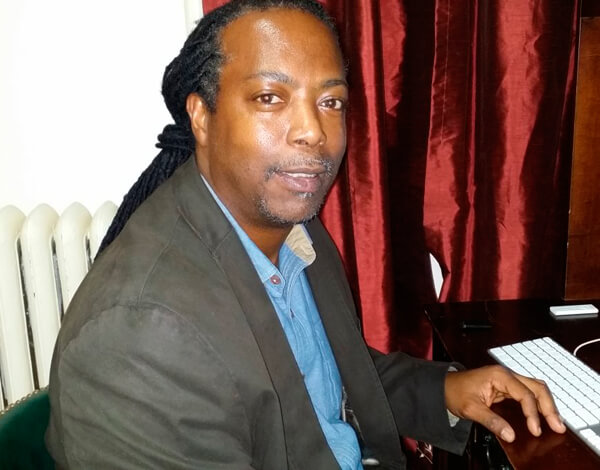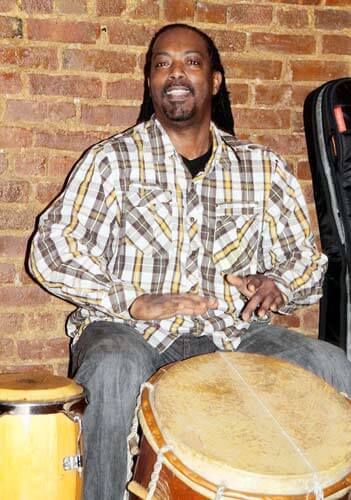“This is our launching of Black History Month,” said Dr. Dario Euraque, Trinity College history professor. “And, we’re giving it a more international focus.”
Dr. Euraque has written extensively on Garifuna social and political history and how they have resisted racism and exclusion by the majority populations in Honduras, Belize, Guatemala and Nicaragua.
Euraque and music professor Eric Galm invited New York-based Afri Garifuna Jazz Ensemble to their Connecticut campus to perform and present, last weekend. Both professors chair their departments and recognize the connection of music to history and culture.
“We’re expanding what is Black History; it’s not just African-American history,” explains Euraque.
Last Friday at noon, ensemble co-director singer Lucy Blanco and Alex Kwabena Colon on Garifuna drum and Kahlil Bell on bongos and conga gave a culture/music workshop to Dr. Galm’s music students along with Trinity faculty Pablo Delano (Studio Arts) and Milla Riggio (English) who lectured about Garifuna-related projects.
The whole six-piece ensemble performed on campus that evening, a prelude with what was to follow.
It was sunny and chilly early the next morning when ensemble members assembled their instruments at The Billings Forge in Hartford. Mario Sprouse set up his keyboard–he had played the onstage grand piano the night before and Luisa Bastidas tuned up her electric violin. High school music students, local musicians, and other music lovers, ages 12-80, filtered into the community space.
“We want to include people from the city; this isn’t just a Trinity event,” said Euraque.
Part of the effort in bringing the ensemble to Hartford was to involve students and established musicians from the larger Hartford community, a way to bridge the campus with the outside world.
James Lovell started off the morning.
“Repeat after me: ‘buiti binafi”, that’s good morning,” he instructed as the workshop began.
Adding a little more Garifuna language to set the tone he said, “‘Idabiangi?’ How are you? Now, repeat.” And, “magadietina”, I am fine.
Lovell gave a very concise history of the Garifuna explaining how the Garifuna are the mixing of three cultures in the mid 17th century, the intermingling of West Africans and the Loon (Arawak) and Kalinago (Carib) native Americans in St. Vincent.
By the late 18th Century, the British wanted to take them off the main island. As the only blacks in the Americans never enslaved, this was a dilemma for the British who were importing slaves for the cotton and sugar trade.
Joseph Chatoyer, the Garifuna chief and leader resisted the British and was killed hallmarking the decline of Garifuna culture in St. Vincent.
On March 11, 1797, all Garifuna women, men and children were removed to a tiny island. After much deprivation and struggle for survival, they eventually arrived in Honduras, settling in 56 villages. The Garifuna were previously known as Black Caribs, a term now shunned.
Updating culture and history, Lovell mentioned current struggles and how the Honduras government was trying to eject Garifuna from their homeland where they have been for 218 years.
Lovell then introduced the drums, the large segundo–the bass. “The smaller– primero drum that looks at the dancers and follows them.” He also mentioned how important the maracas are, also a part of spiritual aspects.
Lovell introduced the rhythms: the paranda a mixture of Spanish and Garifuna rhythms providing tempos for songs rich with social commentary and the punta rhythm, a fast tempo for festive celebrations. He explained how the guitar was introduced through the Spanish to their music in 1797 in Honduras where the Garifuna landed.
“We are going to dialogue through culture. Nothing is better doing that but music,” he said.
During introductions, ensemble members of other ancestry–Dominican, Columbian, and African-American–spoke of their initiation into Garifuna music.
After playing a few songs, the real fun began when the high school students brought up their instruments and with a lot of encouragement and a bit of instruction jammed with ensemble musicians and established musicians from Hartford.
Violinists and siblings Maya Irizarry Lambright, 12, and her brother Mobey, a high school senior, played with violinist Luisa. “It was so beautiful,” Luisa commented afterward. “I saw myself in her, so shy and scared to be wrong. Her brother is very serious and asked me questions about lifestyle and survival. He’s applying to colleges now.”
Percussionist Kahlil Bell also instructed the young students, pointing out that musicians can contribute to the soloist by playing one long note (both, participating and adding texture). The young sax and flute players later commented that this was a valuable piece of instruction.
Co-sponsored by the Hartford Jazz Society, the Afri Garifuna Jazz Ensemble played their fourth event in two days on Saturday night at the local restaurant Casona. An engaged audience — dancing to the last number — was a fitting finale to the days of sharing Garifuna history and music.

















